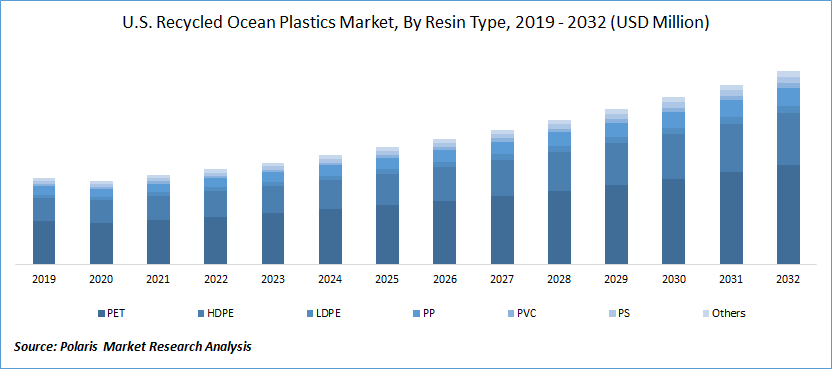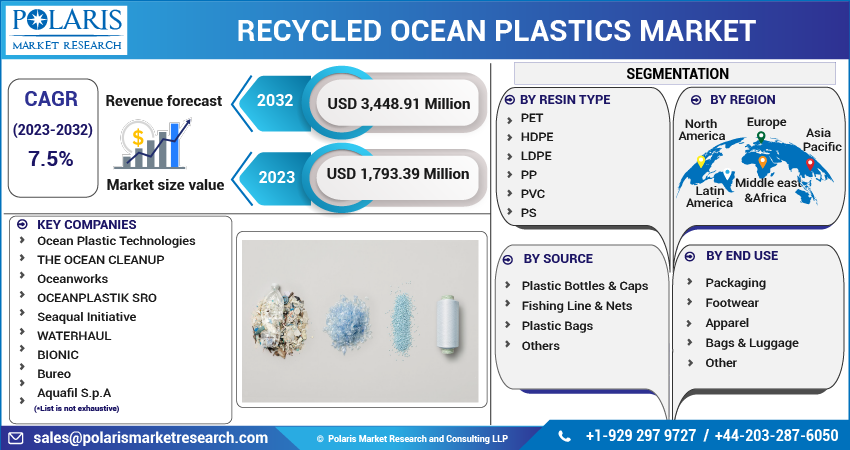
Recycled Ocean Plastics Market Share, Size, Trends, Industry Analysis Report
By Resin Type; By Source (Plastic Bottles & Caps, Fishing Line & Nets, Plastic Bags, Others); By End-Use; By Region; Segment Forecast, 2023 - 2032
- Published Date:May-2023
- Pages: 118
- Format: PDF
- Report ID: PM2575
- Base Year: 2022
- Historical Data: 2019-2021
Report Outlook
The global recycled ocean plastics market was valued at USD 1,673.34 million in 2022 and is expected to grow at a CAGR of 7.5% during the forecast period. The growing awareness of recycling plastic across the globe has increased the growth of the market. Companies are collecting plastics in massive amounts and recycling them. The government authorities, as well as non-profit groups, are actively working on reducing the use of plastic and recycling it.

Know more about this report: Request for sample pages
"Plastics pollution from marine sources" refers to the environmental harm caused by discarded fishing equipment such as nets, lines, ropes, and even abandoned vessels in the ocean. At the global level, United Nations Environment Programme estimates that approximately 80 percent of ocean plastics come from land-based sources and the remaining 20 percent from marine sources.
The proliferation of micro or macro-plastic marine plastics impacts the quality of marine and coastal environments. Ingestion of macro plastics or entanglement in marine wildlife causes harm, negatively affecting ecosystem health and fisheries' overall sustainability.
Plastic waste in the oceans threatens the well-being and survival of seabirds, fish, and marine mammals. This is due to the harmful effects of ingestion, infection, starvation, suffocation, drowning, and entanglement. Sea turtles are the most affected by plastic pollution due to entanglement in ghost gear and suffocation. The human population is also at risk as plastics enter the body through the food chain.
As awareness regarding recycling plastic is growing, and new technologies are emerging in developing economies, the demand for recycled plastic will grow steadily. European countries are engaging more in the recycling plastics market. The Asia Pacific will likely raise the market as governments and companies take the initiative to ban non-recycled plastic.
The COVID-19 pandemic had ramified impact on the growth of the recycled ocean plastics market. The operations of companies in most countries were not operating; as a result, the export-import of raw materials for recycling was unavailable. Social distancing was one reason for a market breakdown, as people were not allowed to work. Soon after the pandemic, the recycled plastic market increased and will have positive outcomes over the forecast period.

For Specific Research Requirements, Request for a Sample Report
Industry Dynamics
Growth Drivers
The surge in demand for recycled ocean plastics from the footwear, apparel, and packaging sectors is primarily propelled by increasing environmental consciousness and the drive toward sustainability, contributing to the growth of recycled ocean plastics market.
According to United Nations Environment Programme, eight million metric tons of plastic waste enter the oceans annually. Currently, most plastic waste goes to landfill or is released into the environment in one way or another. Between 4 and 12 million metric tons of plastic packaging end up in the oceans each year in China and Southeast Asia. It hampers the marine system. Due to plastic pollution’s negative effects on living things, concern is growing about the environment and plastic waste management.
Regions like Europe and US are highly concerned about the increasing ocean plastic waste. Some countries are taken a step to recycle ocean plastic. Many market players are focusing on cleaning technology for recycling ocean plastic.
The apparel and packaging industry highly demands recycled ocean plastic. E-commerce business organizations have seen a huge demand for reasonable consumer gadgets, including PCs, cell phones, modems, etc. The need for recycled plastics in electrical & electronics, and packaging applications has increased due to the increased use of consumer electronics, which is anticipated to drive market growth.
A wide range of plastic resins can be obtained after recycling ocean plastic waste, including polypropylene, polyethylene, polyethylene terephthalate, and others. These materials are used in making end-use products such as sunglasses, phone cases, wallets, footwear, luggage, and clothes. For instance, on May 31, 2021, Adidas partnered with Parley to convert marine plastic into sportswear. It uses recycled plastic bottles instead of virgin polyester.
Changing consumer demands and behaviors can also lead manufacturers to include more recycled plastic. Ocean plastic pollution directly affects the food and packaging industry.
In addition, the expansion of the construction industry in developing nations like China, Brazil, India, and Mexico is anticipated to fuel demand for recycled plastic products used in the production of building materials like structural lumber, insulation, fixtures, windows, and fences.
The structural timber, insulation, windows, and fences widely used in construction are all made from recycled plastic. Increased government investment in infrastructure development and strategies to attract foreign direct investment to emerging economies are expected to drive growth in the building and construction industry.
Report Segmentation
The market is primarily segmented based on resin type, source, end-use, and region.
|
By Resin Type |
By Source |
By End-Use |
By Region |
|
|
|
|
Know more about this report: Request for sample pages
Plastic Bottles & Caps segment accounted for the highest market share in 2022
The plastic Bottles & Caps segment accounted highest market share in 2022 and is likely to retain its position over the anticipated period as they are widely used for packaging various products, such as water, soft drinks, cleaning products, and cosmetics. They are frequently used because of their dependability, affordability, and practicality.
However, plastic bottles and caps can also have negative environmental impacts. When not disposed of properly, they can end up in landfills, oceans, and other natural environments, which can take hundreds of years to degrade. This could be harmful to ecosystems, wildlife, and even human health.
Recycled ocean plastic is an innovative approach to reducing the negative environmental impact of plastic bottles and caps. This involves collecting plastic waste from the ocean, beaches, and other natural environments and transforming it into new products, such as bottles and caps.
Moreover, it is important to note that using recycled ocean plastic to make bottles and caps is only a partial solution to the problem of plastic waste. While it can help reduce plastic waste's environmental impact, it is still a form of plastic. It can still have negative environmental consequences if improperly disposed of or recycled.
Apparel segment held a significant market revenue share in 2022
The apparel segment led the industry and holds the majority of revenue share. The apparel segment in the market is a growing trend in the fashion industry. With increased awareness of the harmful impact of plastic pollution in the oceans, many fashion brands are now looking for ways to use recycled plastic waste to create sustainable and eco-friendly clothing.
Creating apparel from recycled ocean plastics involves collecting plastic waste from the ocean and cleaning and processing it into a material suitable for clothing production. The resulting fabric is then used to create various types of clothing and other products, including t-shirts, hoodies, swimsuits, sunglasses, and shoes. `Additionally, clothing made from recycled ocean plastics is often more durable and resistant to water and sun damage than traditional fabrics.
Some popular brands that use recycled ocean plastics in their apparel include Adidas, Patagonia, and Levi's. As consumer demand for sustainable and eco-friendly products grows, more fashion brands will likely adopt this trend and invest in developing recycled ocean plastic. For instance, Adidas has partnered with Parley for the Oceans to create a line of shoes and apparel made from recycled ocean plastics.
In addition, Patagonia has been using recycled materials in its clothing for years, including fabrics made from recycled plastic bottles. They also sell a line of swimwear made from recycled nylon fishing nets. Several companies now produce apparel made from recycled ocean plastics. These materials come from fishing nets, plastic bottles, and other waste floating in the ocean.
Asia-Pacific dominated the global market in 2022
Asia-Pacific dominated the global industry in 2022 and will likely maintain its dominance over the anticipated period. Asia-Pacific region has been home to numerous government and private initiatives focused on tackling the issue of plastic pollution, including the use of recycled ocean plastic. Several countries in the Asia-Pacific region have implemented policies and regulations to reduce plastic pollution and encourage the use of recycled materials. For instance, Japan has been promoting using recycled ocean plastic in manufacturing consumer goods. Japanese sportswear brand ASICS launched a new line of shoes made from recycled ocean plastic, and the company has committed to using recycled materials in all its products.
North America has been actively involved in the recycled ocean plastic industry, which collects, sorts, processes, and converts ocean plastic waste into valuable materials. The region has been working towards reducing plastic waste in the ocean and increasing recycling rates to protect marine life and promote sustainable practices.
Several North American companies have been leading the charge in this sector, including The Ocean Cleanup, a Dutch non-profit organization that aims to remove plastic from the oceans, and Plastic Bank, a social enterprise that aims to create a circular economy for plastic waste. These companies have implemented innovative solutions such as using blockchain technology and incentivizing local communities to collect ocean plastic waste.
Competitive Insight
Some of the major players operating in the global recycled ocean plastics market include Ocean Plastic Technologies, THE OCEAN CLEANUP, Oceanworks, OCEANPLASTIK SRO, Seaqual Initiative, WATERHAUL, BIONIC, Bureo, Aquafil S.p.A, Tide Ocean SA, PLASTIX, POPSICASE, Parley For the Oceans, and Waste2Wear.
Recent Developments
- In February 2023, The Ocean Cleanup partnered with universities across three continents to study plastic pollution in three urban rivers in the Dominican Republic, South Africa, and Thailand over three years.
- In September 2022, Oceanwork partnered with E. Gluck to expand its Ocean Plastics Collection under the Anne Klein Consider It label.
Recycled Ocean Plastics Market Report Scope
|
Report Attributes |
Details |
|
Market size value in 2023 |
USD 1,793.39 million |
|
Revenue forecast in 2032 |
USD 3,448.91 million |
|
CAGR |
7.5% from 2023 – 2032 |
|
Base year |
2022 |
|
Historical data |
2019 – 2021 |
|
Forecast period |
2023 – 2032 |
|
Quantitative units |
Volume in Kiloton, Revenue in USD million, and CAGR from 2023 to 2032 |
|
Segments Covered |
By Resin Type, By Source, By End-Use, By Region |
|
Regional scope |
North America, Europe, Asia Pacific, Latin America; Middle East & Africa |
|
Key Companies |
Ocean Plastic Technologies, THE OCEAN CLEANUP, Oceanworks, OCEANPLASTIK SRO, Seaqual Initiative, WATERHAUL, BIONIC, Bureo, Aquafil S.p.A, Tide Ocean SA, PLASTIX, POPSICASE, Parley For the Oceans, and Waste2Wear |
FAQ's
The recycled ocean plastics market report covering key segments are resin type, source, end-use, and region.
Recycled Ocean Plastics Market Size Worth $3,448.91 Million By 2032.
The global recycled ocean plastics market expected to grow at a CAGR of 7.5% during the forecast period.
Asia-Pacific is leading the global market.
key driving factors in recycled ocean plastics market are government policies and initiatives.
